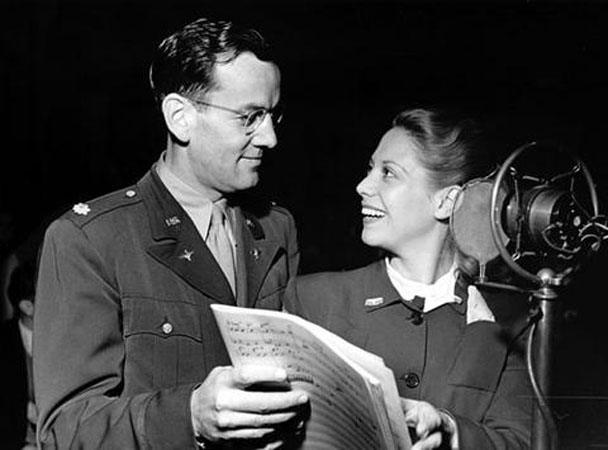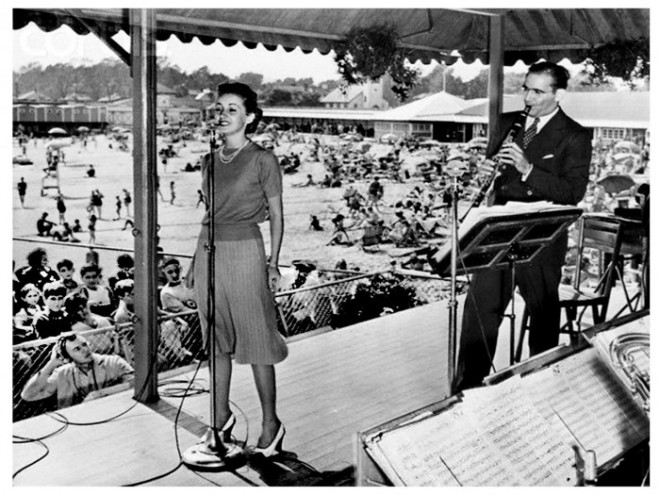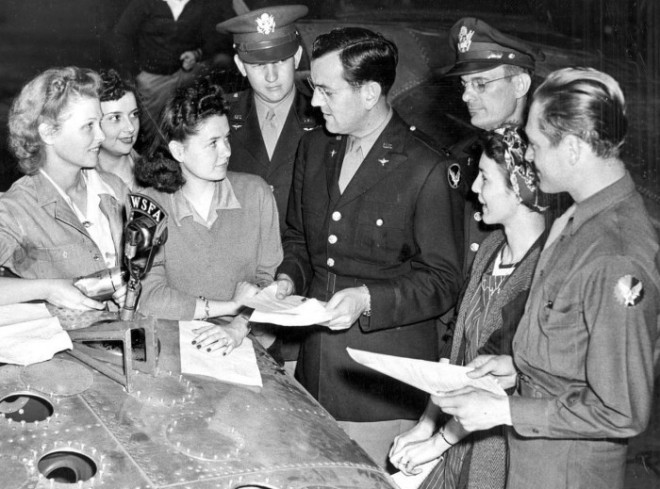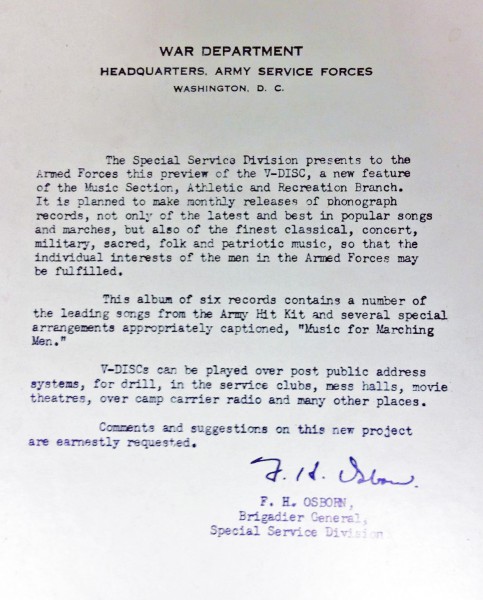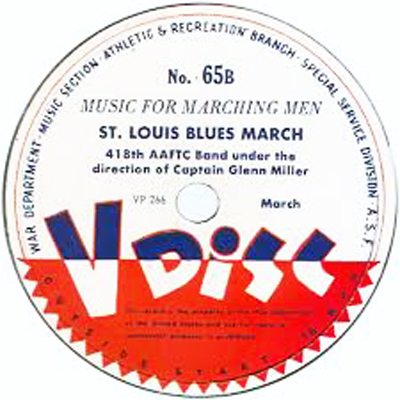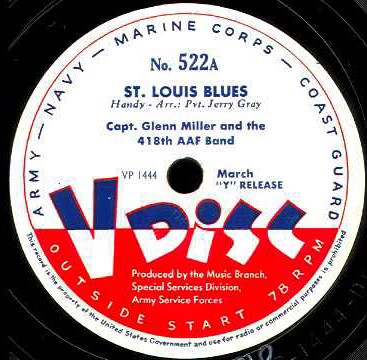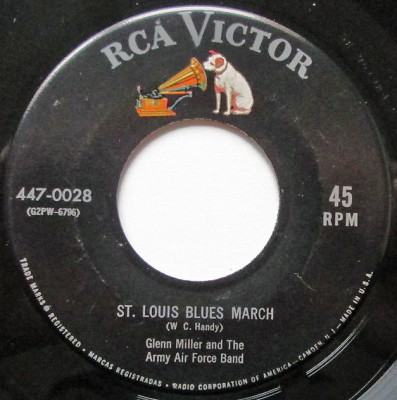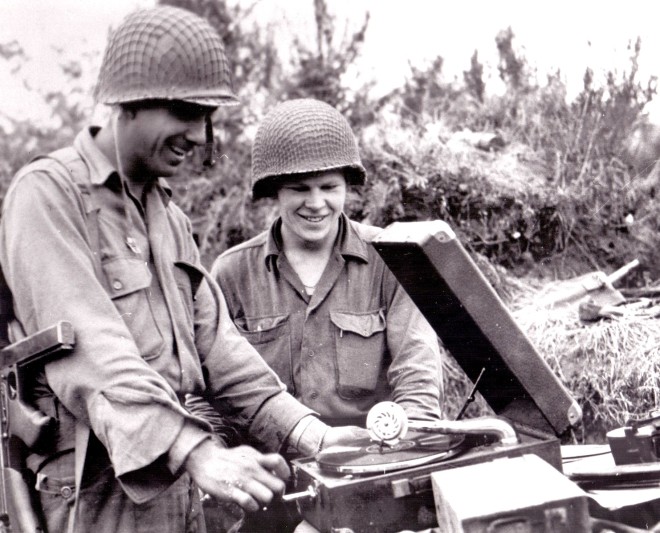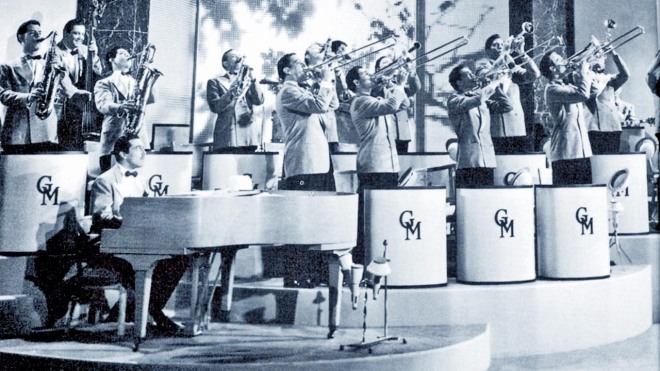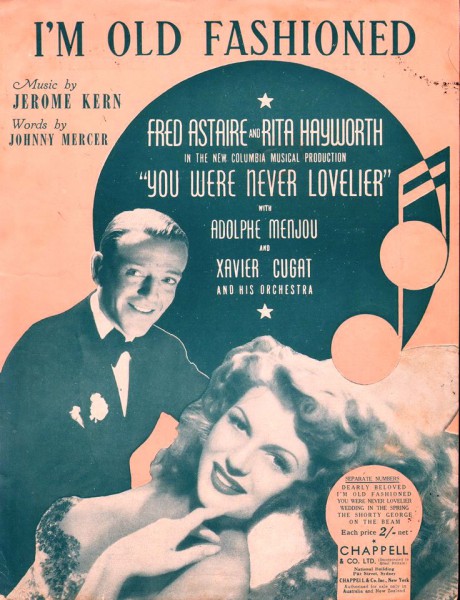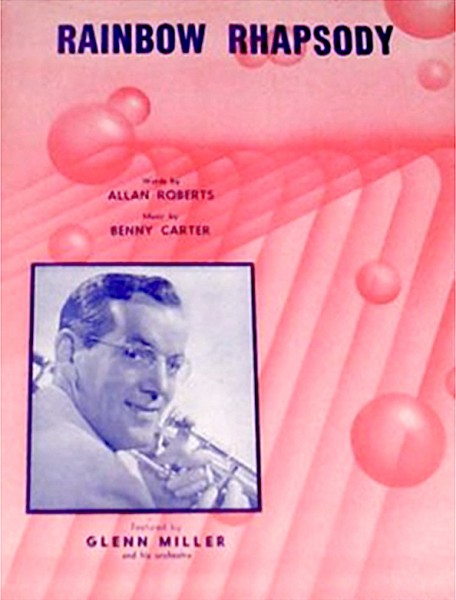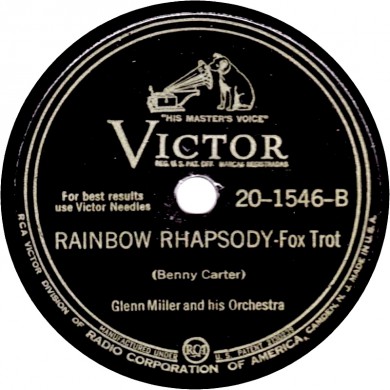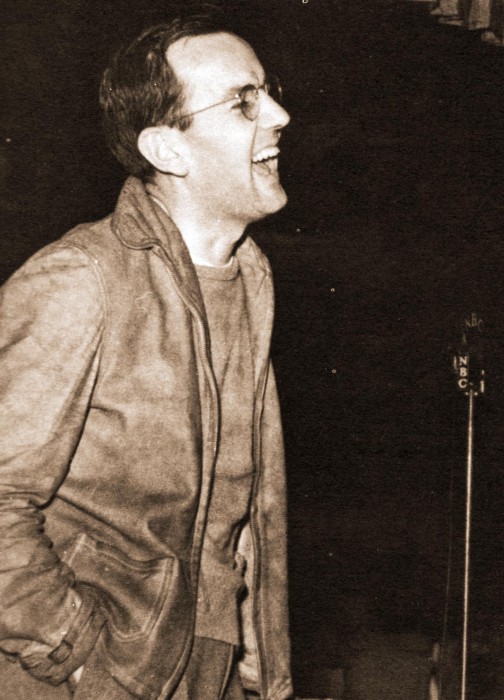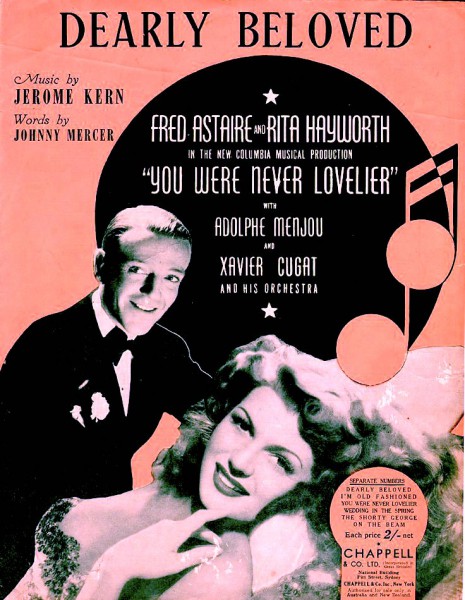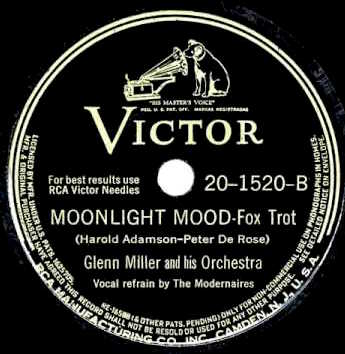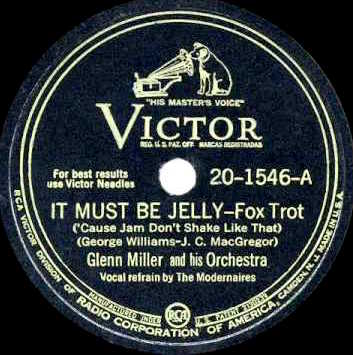Benny Goodman (cl,vcl); Lee Castle, Harold Peppie, Bobby Guyer (tp); Charlie Castaldo, Miff Mole (tb); Hymie Schertzer, Leonard Kaye, Benny Carter (as); Jon Walton, Bob Taylor (onscreen solo recorded by Eddie Miller)(ts); Joe Rushton (bass sax); Jess Stacy (p); Bart Roth (g); Gus Van Camp (b); Louie Bellson (d); Eddie Sauter (arr). Alice Faye & Carmen Miranda (vcl). String section added for “No Love, No Nothin’.”
Film studio pre-recordings, Hollywood, late March/April 1943
Let’s Dance 20th Century Fox TCF233
Minnie’s in the Money (BG vcl) TCF-233
Paducah, Part 1 (BG vcl) TCF-237
Paducah, Part 2 (CM vcl) TCF-238
No Love, No Nothin’ (AF vcl) TCF-240
 Benny Goodman made his first film appearances with his orchestra in 1936 and 1937 in THE BIG BROADCAST OF 1937 and HOLLYWOOD HOTEL. After these well-received features, he made no others for five long years, the period of his greatest popularity.
Benny Goodman made his first film appearances with his orchestra in 1936 and 1937 in THE BIG BROADCAST OF 1937 and HOLLYWOOD HOTEL. After these well-received features, he made no others for five long years, the period of his greatest popularity.
The film studios took awhile to fully embrace the Swing Era. Big bands were well featured in short films (as they had been doing so since the dawn of talkies), but features were a bit harder to crack. Duke Ellington, always a law unto himself, had made guest appearances in a batch of movies starting in 1930, as had Cab Calloway. These were always “specialty” sequences, rarely interacting with the lead characters.
After Goodman’s 1930s films, the concept of building a full-length film around a band began to take hold, though slowly. Artie Shaw actually played a role and had dialogue in his two features, DANCING CO-ED and SECOND CHORUS. With 1940’s LET’S MAKE MUSIC, Bob Crosby began a series of B-musicals starring his band.
Of course, Glenn Miller’s two movies truly showed that a band could carry a film (albeit with star support like skater Sonja Henie) as did Harry James’ PRIVATE BUCKAROO, with the red-hot Andrews Sisters. Jimmy Dorsey was well provided for in THE FLEET’S IN, with Dorothy Lamour, Betty Hutton and William Holden. Johnny Mercer and the film’s director Victor Schertzinger penned the finest score for any big band feature, including “Tangerine,” “I Remember You,” “Not Mine” and “Arthur Murray Taught Me Dancing in a Hurry.”
Brother Tommy Dorsey debuted with the micro-budgeted LAS VEGAS NIGHTS (1940) and then moved up to the slightly larger-budget SHIP AHOY, at MGM with Eleanor Powell. Harry James then had the distinction of being the first top band showcased in Technicolor, with future wife Betty Grable and Carmen Miranda in SPRINGTIME IN THE ROCKIES. The hit song “I Had the Craziest Dream” was an added plus.
With the onerous 1942 recording ban and wartime travel restrictions in place, it was likely easier for bands to make Hollywood their home for lengthy periods. As the King of Swing, Benny Goodman soon began getting the call. Once World War II began, he and his band started popping up in film after film, six over the next two years.
1942 – SYNCOPATION, THE POWERS GIRL, STAGE DOOR CANTEEN
1943 – THE GANG’S ALL HERE
1944 – SWEET AND LOWDOWN, MAKE MINE MUSIC
 THE GANG’S ALL HERE remains the best-remembered Goodman film of the era, mostly for reasons that have little to do with Benny. 20th Century Fox pulled out all the stops for this one – who cared about wartime austerity? The film starred Alice Faye and Carmen Miranda and was acclaimed film choreographer-director Busby Berkeley’s first color assignment. Not just any color – Fox specialized in super-saturated Technicolor photography, which made Alice and Carmen look as luscious as cherry-topped ice-cream sundaes.
THE GANG’S ALL HERE remains the best-remembered Goodman film of the era, mostly for reasons that have little to do with Benny. 20th Century Fox pulled out all the stops for this one – who cared about wartime austerity? The film starred Alice Faye and Carmen Miranda and was acclaimed film choreographer-director Busby Berkeley’s first color assignment. Not just any color – Fox specialized in super-saturated Technicolor photography, which made Alice and Carmen look as luscious as cherry-topped ice-cream sundaes.
The film was also stuffed with familiar character players – Charlotte Greenwood, Edward Everett Horton, Eugene Pallette, Phil Baker, Frank Faylen and dancer Tony DeMarco. Three future stars made brief appearances as showgirls and hat check honeys – Jeanne Crain, June Haver and Adele Jergens.
 After writing the wonderful scores for the two Glenn Miller films and Harry James’ SPRINGTIME IN THE ROCKIES, Fox once again hired composer Harry Warren to write THE GANG’S ALL HERE score, but not with his usual lyricist Mack Gordon. Leo Robin was equally as adept as Gordon and crafted two lovely ballads, “No Love, No Nothin’” and “A Journey to a Star.” Alice Faye delivered both of them, memorably.
After writing the wonderful scores for the two Glenn Miller films and Harry James’ SPRINGTIME IN THE ROCKIES, Fox once again hired composer Harry Warren to write THE GANG’S ALL HERE score, but not with his usual lyricist Mack Gordon. Leo Robin was equally as adept as Gordon and crafted two lovely ballads, “No Love, No Nothin’” and “A Journey to a Star.” Alice Faye delivered both of them, memorably.
With the record ban firmly in place, neither tune got much record coverage though Judy Garland covered both songs on her first post-ban Decca session. It was surprising to find Judy singing Fox songs, rather than numbers from her home studio, MGM.
Since Benny was between vocalists at the time (Peggy Lee having just left the band) he got handed two novelties to sing, “Minnie’s in the Money” and “Paducah.” Both had catchy melodies but rather lame lyrics, with the latter tune reaching for the same sort of success that Warren’s previous two “city songs” had attained – “Chattanooga Choo-Choo” and “I Got a Gal in Kalamazoo.” Even with Carmen Miranda joining in, “Paducah” was a dud. Never the greatest actor, Benny was only handed a few incidental lines. Glenn Miller and Harry James fared better in the acting department in their pictures.
 In addition to the opening number, the Latin classic “Brazil,” Carmen Miranda made the most of her two feature novelties, “You Discover You’re in New York,” “The Lady with the Tutti-Frutti Hat” Director Busby Berkeley made the most of Fox Technicolor, with spectacular, surrealistic effects and over-the-top set pieces, like Carmen Miranda’s dancing bananas and huge fruit hat. The “Polka-Dot Polka” finale tops them all, with neon hoops, wild color shifts and a kaleidoscopic windup, with all the cast members singing a line of “A Journey to a Star” with their heads poked through a shimmering silver curtain. “Buy Your War Bonds at the Theater!”
In addition to the opening number, the Latin classic “Brazil,” Carmen Miranda made the most of her two feature novelties, “You Discover You’re in New York,” “The Lady with the Tutti-Frutti Hat” Director Busby Berkeley made the most of Fox Technicolor, with spectacular, surrealistic effects and over-the-top set pieces, like Carmen Miranda’s dancing bananas and huge fruit hat. The “Polka-Dot Polka” finale tops them all, with neon hoops, wild color shifts and a kaleidoscopic windup, with all the cast members singing a line of “A Journey to a Star” with their heads poked through a shimmering silver curtain. “Buy Your War Bonds at the Theater!”
 The film was so stuffed with songs by the principals, comedy from Carmen, Charlotte Greenwood, Eugene Pallette and Edward Everett Horton, dance routines by Tony DeMarco and Berkeley’s lengthy production numbers that very little time was left for the mundane girl-falls-for-soldier plot, which was just as well. Berkeley was never a great dialogue director and Alice Faye pretty much sleepwalks her way though her on again-off again romance with the less than scintillating James Ellison. With all the male stars off at war, Faye had to make do with the leftovers here.
The film was so stuffed with songs by the principals, comedy from Carmen, Charlotte Greenwood, Eugene Pallette and Edward Everett Horton, dance routines by Tony DeMarco and Berkeley’s lengthy production numbers that very little time was left for the mundane girl-falls-for-soldier plot, which was just as well. Berkeley was never a great dialogue director and Alice Faye pretty much sleepwalks her way though her on again-off again romance with the less than scintillating James Ellison. With all the male stars off at war, Faye had to make do with the leftovers here.
Also, Alice was pregnant during much of the shooting schedule and was not feeling at her best. This would prove to be her last starring Fox musical.
 Getting back to Benny and the boys, this was a band in transition. The draft had decimated his great 1941-42 band and a lot of newcomers were present here, as the personnel on the heading shows. Youngsters Lee Castle, Louis Bellson and Jon Walton play alongside oldsters Miff Mole, Jess Stacy and Hymie Schertzer.
Getting back to Benny and the boys, this was a band in transition. The draft had decimated his great 1941-42 band and a lot of newcomers were present here, as the personnel on the heading shows. Youngsters Lee Castle, Louis Bellson and Jon Walton play alongside oldsters Miff Mole, Jess Stacy and Hymie Schertzer.
The Goodman group swung like crazy during their brief solo spots. The great rhythm section was well recorded, with Jess Stacy and Louis Bellson especially prominent. The band was augmented with strings and a liquid Benny Carter alto solo during Alice Faye’s torcher, “No Love, No Nothin’.” Carter was on the Fox lot working on STORMY WEATHER and other arranging jobs and managed to wedge in this Goodman guest appearance.
 THE GANG’S ALL HERE was one of the last Fox musicals that had special 78rpm pressings done of the songs as souvenir albums for the cast and production people. As with the Glenn Miller films, these albums are pretty rare. With the war going strong, niceties like these discs fell by the wayside and Fox stopped doing them in 1944. Little surprises do pop up on these discs. The “Paducah” record, for example, has several extra band choruses before Carmen Miranda’s vocal that were cut by the time the film was released. Only the Goodman numbers are mentioned above, but there were numerous additional ones as well.
THE GANG’S ALL HERE was one of the last Fox musicals that had special 78rpm pressings done of the songs as souvenir albums for the cast and production people. As with the Glenn Miller films, these albums are pretty rare. With the war going strong, niceties like these discs fell by the wayside and Fox stopped doing them in 1944. Little surprises do pop up on these discs. The “Paducah” record, for example, has several extra band choruses before Carmen Miranda’s vocal that were cut by the time the film was released. Only the Goodman numbers are mentioned above, but there were numerous additional ones as well.
 As one of the most ephemeral of World War II era musicals, THE GANG’S ALL HERE has had a surprising afterlife. In 1974, the film was reissued to theaters in an eye-popping new print and it instantly became a camp classic, primarily for the Busby Berkeley and Carmen Miranda contributions. Reviewers like Rex Reed fell all over themselves to praise Berkeley and the candy-colored backgrounds. Other theatrical revivals followed and the film eventually turned up on the AMC cable network in the 1990s. It took awhile for a home video release, apparently due to problems with the film negative elements.
As one of the most ephemeral of World War II era musicals, THE GANG’S ALL HERE has had a surprising afterlife. In 1974, the film was reissued to theaters in an eye-popping new print and it instantly became a camp classic, primarily for the Busby Berkeley and Carmen Miranda contributions. Reviewers like Rex Reed fell all over themselves to praise Berkeley and the candy-colored backgrounds. Other theatrical revivals followed and the film eventually turned up on the AMC cable network in the 1990s. It took awhile for a home video release, apparently due to problems with the film negative elements.
A 2008 Fox DVD release as past of an Alice Faye boxed set was criticized for its blurry transfer, so a remaster was done the following year and included in a Carmen Miranda set. While an improvement, it still can’t compare with the dazzling theatrical prints seen earlier. At some point, Fox apparently transferred their three-strip Technicolor film negatives to Eastmancolor stock, which has a duller color palette. That’s all we apparently have now.
Still, it remains a delight to see Benny Goodman at his peak in Technicolor, the only one of his band musicals to be filmed that way. It’s also a treat to hear one of the least-recorded Goodman bands in such sparkling fidelity.








 Benny Goodman made his first film appearances with his orchestra in 1936 and 1937 in THE BIG BROADCAST OF 1937 and HOLLYWOOD HOTEL. After these well-received features, he made no others for five long years, the period of his greatest popularity.
Benny Goodman made his first film appearances with his orchestra in 1936 and 1937 in THE BIG BROADCAST OF 1937 and HOLLYWOOD HOTEL. After these well-received features, he made no others for five long years, the period of his greatest popularity. THE GANG’S ALL HERE remains the best-remembered Goodman film of the era, mostly for reasons that have little to do with Benny. 20th Century Fox pulled out all the stops for this one – who cared about wartime austerity? The film starred Alice Faye and Carmen Miranda and was acclaimed film choreographer-director Busby Berkeley’s first color assignment. Not just any color – Fox specialized in super-saturated Technicolor photography, which made Alice and Carmen look as luscious as cherry-topped ice-cream sundaes.
THE GANG’S ALL HERE remains the best-remembered Goodman film of the era, mostly for reasons that have little to do with Benny. 20th Century Fox pulled out all the stops for this one – who cared about wartime austerity? The film starred Alice Faye and Carmen Miranda and was acclaimed film choreographer-director Busby Berkeley’s first color assignment. Not just any color – Fox specialized in super-saturated Technicolor photography, which made Alice and Carmen look as luscious as cherry-topped ice-cream sundaes. After writing the wonderful scores for the two Glenn Miller films and Harry James’ SPRINGTIME IN THE ROCKIES, Fox once again hired composer Harry Warren to write THE GANG’S ALL HERE score, but not with his usual lyricist Mack Gordon. Leo Robin was equally as adept as Gordon and crafted two lovely ballads, “No Love, No Nothin’” and “A Journey to a Star.” Alice Faye delivered both of them, memorably.
After writing the wonderful scores for the two Glenn Miller films and Harry James’ SPRINGTIME IN THE ROCKIES, Fox once again hired composer Harry Warren to write THE GANG’S ALL HERE score, but not with his usual lyricist Mack Gordon. Leo Robin was equally as adept as Gordon and crafted two lovely ballads, “No Love, No Nothin’” and “A Journey to a Star.” Alice Faye delivered both of them, memorably. In addition to the opening number, the Latin classic “Brazil,” Carmen Miranda made the most of her two feature novelties, “You Discover You’re in New York,” “The Lady with the Tutti-Frutti Hat” Director Busby Berkeley made the most of Fox Technicolor, with spectacular, surrealistic effects and over-the-top set pieces, like Carmen Miranda’s dancing bananas and huge fruit hat. The “Polka-Dot Polka” finale tops them all, with neon hoops, wild color shifts and a kaleidoscopic windup, with all the cast members singing a line of “A Journey to a Star” with their heads poked through a shimmering silver curtain. “Buy Your War Bonds at the Theater!”
In addition to the opening number, the Latin classic “Brazil,” Carmen Miranda made the most of her two feature novelties, “You Discover You’re in New York,” “The Lady with the Tutti-Frutti Hat” Director Busby Berkeley made the most of Fox Technicolor, with spectacular, surrealistic effects and over-the-top set pieces, like Carmen Miranda’s dancing bananas and huge fruit hat. The “Polka-Dot Polka” finale tops them all, with neon hoops, wild color shifts and a kaleidoscopic windup, with all the cast members singing a line of “A Journey to a Star” with their heads poked through a shimmering silver curtain. “Buy Your War Bonds at the Theater!” The film was so stuffed with songs by the principals, comedy from Carmen, Charlotte Greenwood, Eugene Pallette and Edward Everett Horton, dance routines by Tony DeMarco and Berkeley’s lengthy production numbers that very little time was left for the mundane girl-falls-for-soldier plot, which was just as well. Berkeley was never a great dialogue director and Alice Faye pretty much sleepwalks her way though her on again-off again romance with the less than scintillating James Ellison. With all the male stars off at war, Faye had to make do with the leftovers here.
The film was so stuffed with songs by the principals, comedy from Carmen, Charlotte Greenwood, Eugene Pallette and Edward Everett Horton, dance routines by Tony DeMarco and Berkeley’s lengthy production numbers that very little time was left for the mundane girl-falls-for-soldier plot, which was just as well. Berkeley was never a great dialogue director and Alice Faye pretty much sleepwalks her way though her on again-off again romance with the less than scintillating James Ellison. With all the male stars off at war, Faye had to make do with the leftovers here. Getting back to Benny and the boys, this was a band in transition. The draft had decimated his great 1941-42 band and a lot of newcomers were present here, as the personnel on the heading shows. Youngsters Lee Castle, Louis Bellson and Jon Walton play alongside oldsters Miff Mole, Jess Stacy and Hymie Schertzer.
Getting back to Benny and the boys, this was a band in transition. The draft had decimated his great 1941-42 band and a lot of newcomers were present here, as the personnel on the heading shows. Youngsters Lee Castle, Louis Bellson and Jon Walton play alongside oldsters Miff Mole, Jess Stacy and Hymie Schertzer. THE GANG’S ALL HERE was one of the last Fox musicals that had special 78rpm pressings done of the songs as souvenir albums for the cast and production people. As with the Glenn Miller films, these albums are pretty rare. With the war going strong, niceties like these discs fell by the wayside and Fox stopped doing them in 1944. Little surprises do pop up on these discs. The “Paducah” record, for example, has several extra band choruses before Carmen Miranda’s vocal that were cut by the time the film was released. Only the Goodman numbers are mentioned above, but there were numerous additional ones as well.
THE GANG’S ALL HERE was one of the last Fox musicals that had special 78rpm pressings done of the songs as souvenir albums for the cast and production people. As with the Glenn Miller films, these albums are pretty rare. With the war going strong, niceties like these discs fell by the wayside and Fox stopped doing them in 1944. Little surprises do pop up on these discs. The “Paducah” record, for example, has several extra band choruses before Carmen Miranda’s vocal that were cut by the time the film was released. Only the Goodman numbers are mentioned above, but there were numerous additional ones as well. As one of the most ephemeral of World War II era musicals, THE GANG’S ALL HERE has had a surprising afterlife. In 1974, the film was reissued to theaters in an eye-popping new print and it instantly became a camp classic, primarily for the Busby Berkeley and Carmen Miranda contributions. Reviewers like Rex Reed fell all over themselves to praise Berkeley and the candy-colored backgrounds. Other theatrical revivals followed and the film eventually turned up on the AMC cable network in the 1990s. It took awhile for a home video release, apparently due to problems with the film negative elements.
As one of the most ephemeral of World War II era musicals, THE GANG’S ALL HERE has had a surprising afterlife. In 1974, the film was reissued to theaters in an eye-popping new print and it instantly became a camp classic, primarily for the Busby Berkeley and Carmen Miranda contributions. Reviewers like Rex Reed fell all over themselves to praise Berkeley and the candy-colored backgrounds. Other theatrical revivals followed and the film eventually turned up on the AMC cable network in the 1990s. It took awhile for a home video release, apparently due to problems with the film negative elements.


